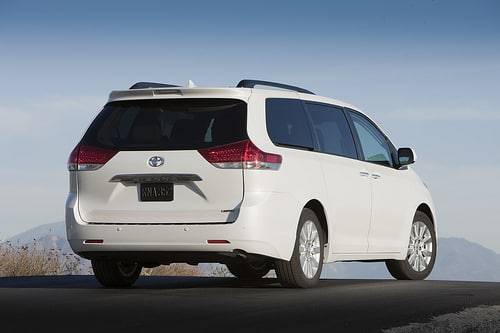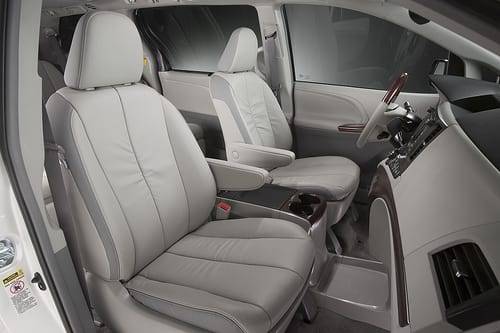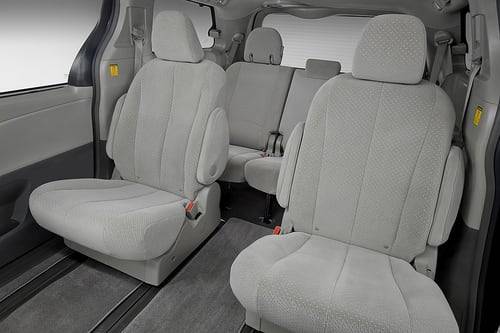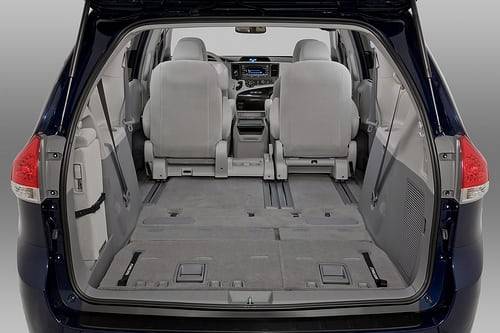2011 Toyota Sienna: First Drive

No stranger to minivans, Toyota has thrown a lot of darts at the board with the redesigned 2011 Sienna. Features run the gamut from functional — the Sienna is the only minivan with optional all-wheel drive and is the first in a long while to offer a four-cylinder engine — to pie-in-the-sky: Loaded models can have dual moonroofs and rear lounge seats with footrests. There’s even a sport-tuned Sienna SE for parents inclined to carve corners en route to Sally’s slumber party.
It’s a good thing the minivan behind the frills stands up. Though flawed in a couple key respects, the Sienna’s fundamentals are sound. Toyota seems to think the minivan segment is headed for a rebirth. Sales indicate that the top players in the minivan segment are holding their own with three-row crossovers.
I’m skeptical a larger surge is in the cards. However, if you’re not high-tailing it out for a crossover, this particular minivan deserves a look. We had a chance to drive the Sienna in California, and we’ll have full review of the model, which hits dealerships in February, up on Monday, including our impressions of the sport-tuned Sienna SE. Below is an early take on that review. We’ll have a full photo gallery and video tomorrow.

Handsome, for a Minivan
With obvious similarities to the FT-MV concept shown at the 2007 Tokyo auto show — the acronym stood, perhaps more obviously, for “Future Toyota Minivan” — the Sienna looks handsome. We’ve had a little over a year to absorb the Camry-based Venza’s left-field face, which makes it easier to digest the Sienna’s same approach on a larger canvas. It doesn’t seem quite so overbearing. Short front overhangs, a tasteful rear spoiler, included standard, and wraparound taillights complete the look. As minivans go, it’s handsome.

Ample Power
Toyota’s 266-horsepower, 3.5-liter V-6, a staple from last year’s Sienna and a number of other models, is back in the saddle on most trim levels. Alas, it works through an oafish six-speed automatic that prefers to reach 5th or 6th gear as soon as possible and, when called upon to downshift, hunt indecisively for the right gear. The outgoing Sienna’s five-speed automatic, which I drove in a 2009 model last spring, felt far more responsive. But Toyota’s 3.5-liter V-6 is a gem, and once the transmission fetches the right gear, it delivers confident thrust and a throaty, satisfying exhaust note. All told, the Sienna’s V-6 feels beefier than the Honda Odyssey’s, and probably as gutsy as the Dodge Grand Caravan’s 4.0-liter V-6.
Toyota’s 187-hp, 2.7-liter four-cylinder, of recent Venza and Highlander vintage, will also be available; it’s also matched to a six-speed automatic. At the L.A. Auto Show, where the Sienna was introduced, I questioned the wisdom of offering a four-cylinder on a large minivan. Color me convinced. Pushed hard, the four-cylinder emits a coarse roar to the V-6’s refined growl, but it’s capable enough, moving the Sienna smartly around town. The drivetrain doesn’t run out of steam until the highway, where 60-70 mph passing feels a bit lethargic, and the transmission still gets stage fright picking the right gear. Of course, I drove the four-cylinder with just one other person in the car — the Sienna’s chief engineer, Kazuo Mori — and it’s likely a full load of passengers could prove to be too much weight. If you’re shopping the four-cylinder, see if you can rope a few family members along to make sure you’re comfortable with the power.
EPA-estimated gas mileage works out to 19/26 mpg (city/highway) for the four-cylinder — better than the 17/25 mpg rating both the Odyssey and Grand Caravan attain with V-6s. The V-6 in the Sienna gets 18/24 mpg with front-wheel drive and 16/22 mpg with all-wheel drive, which is still competitive.

Ride & Handling
Ride quality, a strength for the last Sienna, remains strong. In all but the sport-tuned Sienna SE, the suspension fairly glides over bumps, maintaining excellent cabin comfort. Wind noise on the highway is fairly low, too. Although on a couple models with 17-inch wheels, I noticed more road noise than I’d expect for a minivan.
The Sienna’s steering wheel turns easily at low speeds, but it doesn’t satisfy quite like it used to. The last Sienna’s wheel would glide with buttery, Lexus-like smoothness — something that set the minivan apart from its competitors. This one feels a tad artificial. On the highway, I could also use a bit less power-steering assist; the wheel feels firm enough at 40 mph or so, but at 60 mph or 70 mph it seems a bit loose in the 12 o’clock position.
Body roll comes with any quick off-ramp jaunts, but it isn’t an ever-present force like in some top-heavy crossovers. The brakes — four-wheel antilock discs – feel strong overall, but it takes a few inches of pedal travel before they bite down. Others have more linear response.

Road-Trip Ready
Toyota says it designed the cabin to give the driver and front passenger a perception of personal space. There’s a bit of truth to it. The Sienna’s low roofline clips a bit off the windshield, but the dashboard’s swooshed trimmings lend the impression of space. Typical of a minivan, you’ll be able to fill it up with all manner of riffraff. There are upper and lower glove compartments — both generously sized — plus two sturdy pull-out cupholders, large door pockets and a matted floor tray for a purse. I’m lukewarm on the Sienna’s optional center console; with two cupholders and a large storage compartment, it gets the job done. But it doesn’t convert to a pass-through like the Odyssey’s, nor does it have the tricks of the Grand Caravan’s jack-of-all-consoles.
Materials quality is middling; areas you’ll regularly touch, like the upper door panels, are clad in cheap, unpadded plastics. That’s the case for a lot of crossovers and just about every minivan these days. Toyota’s materials look good, at least, with similar graining to the stuff in the Prius and Venza. Controls are logically placed and easy to operate, and most of them operate with high-quality precision. A couple common-sense features deserve calling out: The speedometer’s 10-mph increments make it far easier to see your speed than rivals’ 20-mph readouts, and the Sienna’s massive, extendable sun visors are ready for serious duty.
Over a half-day of driving, I found the front seats reasonably comfortable, with durable, high-rent fabric in the Sienna LE that I spent the most time in. (The base Sienna, Mori told me, has a lesser fabric; there wasn’t one at the event to check out.) The Sienna’s leather upholstery, standard on the XLE and Limited, feels upscale — though not any more than the cowhide elsewhere in this league.
The adjustable second row — offered in two- and three-seat configurations — offers some 26 inches of fore/aft adjustment range. That’s enough to yield near-infinite legroom should you have the seats all the way back, and the chairs sit high enough off the floor for good thigh support. Third-row room depends on where the second-row seats are positioned, but adults should be able to work out a compromise so both have decent room. (With others in the car, we did.) Headroom in both rows is adequate.
The third row folds flat into the floor like most crossovers’ and all minivans’ third rows do. It’s an easier process than the Odyssey’s — ironic, given Honda was one of the pioneers of stowable third rows — and, on the Sienna Limited, it does so with the push of a button.
Cargo volume behind the third row totals 39.1 cubic feet, with 87.1 cubic feet when the third row is folded and the second-row seats are deployed. The second-row seats don’t fold into the floor like Chrysler’s do, nor do they fold down like most others. Instead, they lock into a sort of collapsed-forward position, yielding 117.8 cubic feet of cargo volume behind them. You can remove them for a class-leading 150.0 cubic feet of space — proof positive that minivans, once again, are still more space efficient than crossovers or SUVs.

The Final Word
Safety features include the usual gamut of airbags, antilock brakes and stability control. The big question: Are there enough minivan buyers to sustain the Sienna’s future? I’d like to think so; the fundamental utility of a minivan is hard to beat, and enough buyers recognize that to overcome the stigma of getting a bona fide mom-mobile. And dads can always compromise on the sporty SE.

Former Assistant Managing Editor-News Kelsey Mays likes quality, reliability, safety and practicality. But he also likes a fair price.
Featured stories




